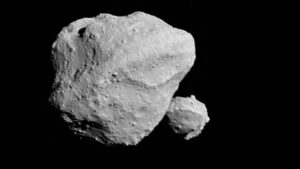
Back in October 2021, a mission called Lucy lifted off on a multi-year journey to visit Jupiter’s two collections of Trojan Asteroids. Today, it is making its way through the asteroid belt before circling back to use the Earth to get a gravitational assist in 2024.
While the asteroid belt is mostly empty space, researchers will go out of their way to match spacecraft trajectories with asteroid orbits to try and make sure no spacecraft passes through the belt without seeing at least one asteroid… or maybe 2.
On November 1, Lucy flew past the asteroid Dinkinesh. Discovered in 1999, this system is about 0.7km across. It was seen to vary in brightness, and it was assumed to be just rotational effects. As Lucy got closer and closer to this distant space rock, researchers began to wonder if maybe, just maybe, they were actually seeing light from a second asteroid orbiting Dinkinesh like a moon or binary asteroid.
And… in the November 1 image… we clearly see Dinkinesh has a friend. Estimated to be about 220 meters in size, this companion is still unnamed, and represents one heck of a lucky find.
Slide 6
In a quote that pleases my Gen X heart, principal investigator Hal Levison explains, “When Lucy was originally selected for flight, we planned to fly by seven asteroids. With the addition of Dinkinesh, two Trojan moons, and now this satellite, we’ve turned it up to 11.” Or maybe even 12… That bonus object is a contact binary!

